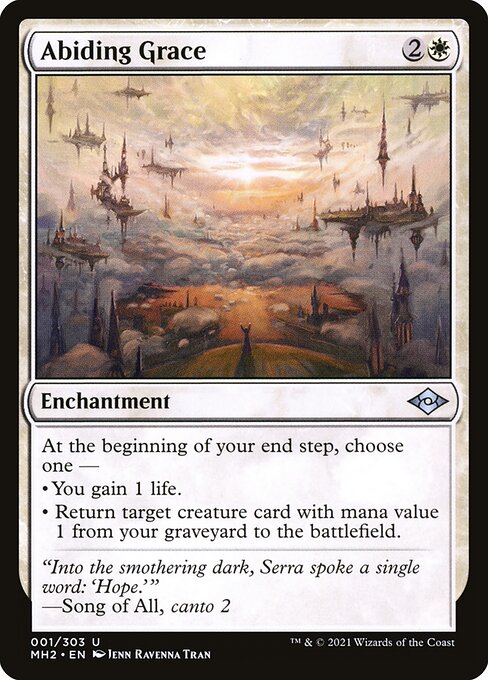
Image courtesy of Scryfall.com
Graceful Late-Game Turns with Abiding Grace
White has long excelled at turning small advantages into lasting inevitabilities, and Abiding Grace is a perfect reminder that the late game often pivots on subtle, vanishingly small decisions. This Modern Horizons 2 enchantment, with its modestmana cost of {2}{W}, doesn’t shout for attention. Instead it slips into the background, quietly stacking value as the game stretches toward its final acts 🧙♂️🔥. At the start of your end step, you choose one: you gain 1 life, or you return a target creature card with mana value 1 from your graveyard to the battlefield. Two options, one compact frame, and a lot of late-game potential that can swing tempo, life totals, and board presence all at once 💎⚔️.
Two end-step options that compound over time
- You gain 1 life — a reliable life buffer in grindy matchups or burn-heavy metas. In long, attrition-heavy games, lifegain is a resource you can use as a premium currency. It buys you a few extra turns, survivability, and the possibility of riding out a stale board until your other engines—like Abiding Grace's recursion—can reboot your plan 🧙♂️.
- Return a 1 mana value creature card from your graveyard — the sneaky engine. While a single 1-CMC reanimation might look modest, the cumulative value is what matters. Reanimating a small defensive creature or a utility creature on multiple end steps can gradually rebuild your board presence, especially if you’ve filled your graveyard with cheap, resilient threats or cost-efficient utility bodies. In games that drag on, those returns become the heartbeat of your late-game resilience 🎲.
Where Abiding Grace fits in typical white archetypes
Abiding Grace shines brightest in white-based attrition or value-oriented shells. In archetypes that care about lifegain or graveyard interactions, it acts as a quiet victory conditioner. Imagine a build that leverages small but sticky creatures, life-linked bodies, and a few sacrifice outlets or enter-the-battlefield effects. Each end step, you’re choosing between a guaranteed lifegain trickle or a well-timed redeployment from the graveyard. The net effect is a steadily increasing floor: even if the board is quiet, your life total can climb, and your 1-CMC targets can reappear to push the board forward again and again 🧙♂️💎.
In practical terms, consider a deck that packs 1-CMC white creatures, plus a couple of cheap recursive threats and a handful of value permanents. Abiding Grace provides two parallel rails of value: you either tighten your life total to weather burn or glide a creature back into play to assert inevitability on the battlefield. It’s not flashy, but it’s dependable—exactly the kind of power that scales gracefully as the game approaches its final chapters 🔥🎨.
Late-game sequencing and timing considerations
Because the trigger happens at the beginning of the end step, your sequencing matters. If you’re ahead, you might opt for the life gain to push your life total into a safer range against opposing stax or aggressive lists. If you’re behind, populating your graveyard with suitable 1-CMC creatures earlier in the game pays dividends on Abiding Grace turns later. The trick is to pre-plan targets you’d enjoy reanimating: small, unblockable creatures for pressure, cheap defensive bodies for blocking, or utility creatures that enable further interactions on subsequent turns. In long games, those micro-plays accumulate into a strategic edge that can be the difference between a hard-fought victory and a narrow defeat 🧙♂️⚔️.
Flavor and mechanics align beautifully here. The card’s flavor text—“Into the smothering dark, Serra spoke a single word: 'Hope.'”—echoes the card’s role as a beacon in late-game corridors. It’s a reminder that strategic lifegain and timely recursion can illuminate even the most dim paths, offering a tangible sense of relief when the end seems near. The design is elegantly simple: low mana cost, reliable end-step effect, and credible lines of play that reward planning and patience 🎨.
“Into the smothering dark, Serra spoke a single word: 'Hope.'” — Song of All, canto 2
Practical tips to maximize Abiding Grace value
- Build a graveyard with intent. Include a few robust 1-CMC creatures that you’d enjoy reanimating, so you’re not fishing in a crowded pool when the end step arrives.
- Weigh your end-step choice strategically. If you’re near a life-total cliff, lifegain can buy you safe passage. If you’re pressuring with a reanimated body, the second option can push your advantage forward.
- Complement with graveyard-friendly or reanimate-friendly support. Cards that nudge value from the graveyard or that leverage small creatures for bigger effects can turn Abiding Grace into a recurring engine rather than a one-off swing.
- Account for color identity and deck pace. In a lean white shell, the mana efficiency is a blessing; in a multi-color board, ensure you have a clear plan to protect or utilize the returned creature efficiently.
Ultimately, Abiding Grace is a patient card. It asks you to play the long game with dignity, to lean on small increments of advantage, and to savor the moment when your end-step choice flips the script in your favor 🧙♂️💎. If your strategy leans into endurance and reclamation, this enchantment quietly becomes the hinge on which your late-game turns swing in glorious style ⚔️.
Non-Slip Gaming Mouse PadMore from our network
- https://blog.rusty-articles.xyz/blog/post/nekrata-avatar-long-term-performance-across-sets/
- https://transparent-paper.shop/blog/post/how-to-build-effective-banner-templates-for-small-businesses/
- https://blog.digital-vault.xyz/blog/post/predicting-sunspear-shikari-reprints-statistical-insights/
- https://blog.digital-vault.xyz/blog/post/blue-hot-giant-at-7160-light-years-explains-dwarf-giants/
- https://crypto-acolytes.xyz/blog/post/retro-shooters-that-inspired-the-modern-fps-era/